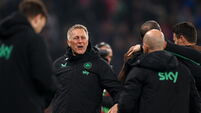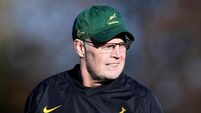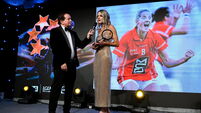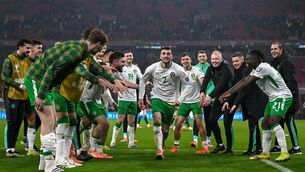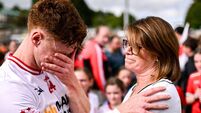Eimear Ryan: Female athletes no longer the token in the room
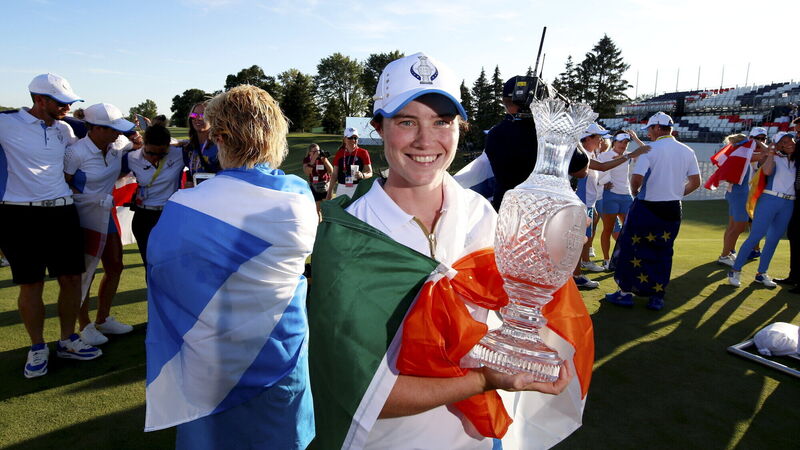
Ireland's Leona Maguire was a key part of Team Europe's Solheim Cup success. Picture: Brian Spurlock/Sportsfile
For the past few weeks I’ve been glued to the new season of Succession, Jesse Armstrong’s superb family boardroom drama. Best described as Rupert Murdoch’s News Corp meets King Lear, it’s a show in which every character is strangely sympathetic despite being, objectively, a terrible person.
The current storyline sees patriarch Logan Roy stepping down as CEO in the midst of a #MeToo scandal and choosing an interim CEO from among his underlings. It is generally agreed that a female CEO would be best, for ‘optics’. Or, as eldest son Kendall puts it sardonically to his sister, Siobhan: “Girls count double now. Didn’t you know?”
Ah, tokenism: the thing that every woman in public life secretly fears. Even when you know you’re capable, and have put in the time and work to be where you are, you’ll sometimes wonder if you’re there because of your talents or for the aforementioned ‘optics’. And there will always be someone to accuse you of being a token – especially when you’re the only woman in the room.
It’s refreshing, then, to look at the landscape of Irish sports lately, and to witness all the women excelling at the top of their respective fields. In a recent survey by the Marketing Institute of Ireland, Olympic boxing champion Kellie Harrington was named as the country’s most marketable athlete.
Five out of the top six named, in fact, were women: Katie Taylor, Rachael Blackmore, Ellen Keane and Leona Maguire. (Inside the top six, a solitary Shane Lowry flew the flag for the lads.) In the marketability stakes, it seems that girls are counting for more than double at present.
It’s easy to see why Harrington, with her sunny, down-to-earth disposition, coupled with her fierceness in the ring, is a brilliant role model – not just for young people in sports, but for working class kids and LGBTQ youth. Blackmore, a champion in one of those rare sports where men and women compete against each other, is an inspirational pioneer. Keane is a brilliant example of consistency at elite level and of improvement over time, winning gold at her third Paralympics (she was just 13 at her first). As the first Irish golfer in the Solheim Cup, Maguire broke the all-time rookie points record in either the Solheim or the Ryder Cup, endearing herself to an entire continent by helping Europe to secure the win. And Taylor is an outlier, a once in a generation talent.
And these are just individual athletes. Throw in the likes of Katie McCabe, in the form of her life with both Arsenal and Ireland, and looking forward to an FA Cup final in early December. On the Gaelic games front, there’s the Meath trio of Emma Duggan, Emma Troy and Vikki Wall, all nominated for Player of the Year; and their camogie counterparts, Galway’s Aoife Donohue and Niamh Kilkenny, and Cork’s Hannah Looney. All had exceptional years, and perhaps more importantly, enough of their games were televised that we, the audience, were able to appreciate their prowess. Excellence doesn’t happen in a vacuum anymore.
Revolutionary changes in the media, especially over the last decade-plus, have contributed hugely to this shift for women’s sports.
Platforms are not finite anymore; coverage is no longer confined to X amount of pages or the scheduling constraints of a handful of TV channels. This has been liberating for women’s sport, as it no longer has to justify why it’s taking space that was traditionally reserved for men (let’s face it, there are plenty who still have this attitude). Now, coverage of women’s sport can sit peaceably alongside coverage of men’s – not instead of, but in addition to.
Podcasts and streaming services have opened up the space for broadcast and discussion of women’s sports; just this week, Off The Ball added a show dedicated to the Irish women’s soccer team, The COYGIG Pod, to its raft of podcasts. Online-only platforms like The Athletic and The Equalizer have embraced and centred female athletes. In this brave new multi-platform world, a continual stream of content is essential, and women’s sport is an increasingly important tributary.
Part of the freshness of women’s sport is that, to a large extent, it’s untrodden territory; there are so many stories yet to be told, and the discourse isn’t as mired in cliché as it is in more well-established (read: male) sports. And for all the commonalities they share with their male counterparts, women approach sport from a different point of view: different backgrounds, challenges and concerns. Finally, people are becoming interested in the stories of female athletes because of – not despite – the fact that they are women.
Maybe the Marketing Institute report should be taken with a pinch of salt; marketing is all about bigging things up, after all. But then, marketing is also about predicting trends. All the signs point to the rise and rise of women’s sport – and one would hope that the higher-ups in women’s sports are poised to make hay while the sun shines.
Increased cooperation between bodies like the LGFA and the Camogie Association will be crucial in maximising the increased interest in watching women play sport. For example, why shouldn’t the All-Ireland camogie and ladies’ football finals be held on the same Sunday? (Credit to Gemma O’Connor, who floated this idea at a recent Barrs gathering.)
Like all good ideas, it’s so simple and obvious you wonder why it isn’t the case already.
In pre-Covid times, the most recent ladies football finals were averaging attendances of 50,000; the camogie finals were hitting about half that. Put them together, and you fill Croke Park. A cracking double-bill, a festival of female sport, an inspirational day out for girls, and a fitting audience for our top-tier women hurlers and footballers: it’s a no-brainer.

